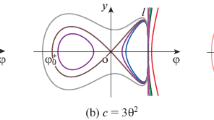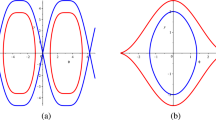Summary
In this paper we consider a modulation (or amplitude) equation that appears in the nonlinear stability analysis of reversible or nearly reversible systems. This equation is the complex Ginzburg-Landau equation with coefficients with small imaginary parts. We regard this equation as a perturbation of the real Ginzburg-Landau equation and study the persistence of the properties of the stationary solutions of the real equation under this perturbation. First we show that it is necessary to consider a two-parameter family of traveling solutions with wave speedυ and (temporal) frequencyθ; these solutions are the natural continuations of the stationary solutions of the real equation. We show that there exists a two-parameter family of traveling quasiperiodic solutions that can be regarded as a direct continuation of the two-parameter family of spatially quasi-periodic solutions of the integrable stationary real Ginzburg-Landau equation. We explicitly determine a region in the (wave speedυ, frequencyθ)-parameter space in which the weakly complex Ginzburg-Landau equation has traveling quasi-periodic solutions. There are two different one-parameter families of heteroclinic solutions in the weakly complex case. One of them consists of slowly varying plane waves; the other is directly related to the analytical solutions due to Bekki & Nozaki [3]. These solutions correspond to traveling localized structures that connect two different periodic patterns. The connections correspond to a one-parameter family of heteroclinic cycles in an o.d.e. reduction. This family of cycles is obtained by determining the limit behaviour of the traveling quasi-periodic solutions as the period of the amplitude goes to ∞. Therefore, the heteroclinic cycles merge into the stationary homoclinic solution of the real Ginzburg-Landau equation in the limit in which the imaginary terms disappear.
Similar content being viewed by others
References
D. Armbruster, J. Guckenheimer, and P. Holmes (1988) Heteroclinic cycles and modulated travelling waves in systems with O(2) symmetry.Phys. 29D 257–282.
M. Bartuccelli, P. Constantin, C. R. Doering, J. D. Gibbon, and M. Gisselfält (1990) On the possibility of soft and hard turbulence in the complex Ginzburg-Landau equation.Phys. 44D 421–444.
N. Bekki and B. Nozaki (1985) Formations of spatial patterns and holes in the generalized Ginzburg-Landau equation.Phys. Lett. 110A 133–135.
D. Bensimon, P. Kolodner, C. M. Surko, H. Williams, and V. Croquette (1990) Competing and coexisting dynamical states of traveling-wave convection in an annulus.J. Fluid Mech. 217 441–467.
A. J. Bernoff (1988) Slowly varying fully nonlinear wavetrains in the Ginzburg-Landau equation.Phys. 30D 363–381.
J. M. Borwein and P. B. Borwein (1987)Pi and the AGM. New York: John Wiley & Sons.
H. R. Brand and M. C. Cross (1983) Phase dynamics for the wavy vortex state of the Taylor instability.Phys. Rev. A 27 1237–1239.
H. R. Brand and R. J. Deissler (1989) Interaction of localized structures for subcritical bifurcation.Phys. Rev. Lett. 63 2801–2804.
J. Carr (1981)Applications of Centre Manifold Theory. New York: Springer-Verlag.
P. Collet and J. P. Eckman (1990) The time dependent amplitude equation for the Swift-Hohenberg problem.Comm. Math. Phys. 132 139–153.
R. C. DiPrima, W. Eckhaus, and L. A. Segel (1971) Non-linear wave-number interaction in near-critical two-dimensional flows.J. Fluid Mech. 49 705–744.
A. Doelman (1989) Slow time-periodic solutions of the Ginzburg-Landau equation.Phys. 40D 156–172.
A. Doelman and W. Eckhaus (1991) Periodic and quasi-periodic solutions of degenerate modulation equations.Phys. 53D 249–266.
C. R. Doering, J. D. Gibbon, D. D. Holm, and B. Nicolaenko (1988) Low dimensional behaviour in the complex Ginzburg-Landau equation.Nonlin. 1 279–310.
E. Dubois-Violette and M. Gabay (1982) The thermal oscillatory instability in a homeotropic nematic: an inverse bifurcation.J. Phys. France 43 1305–1317.
W. Eckhaus (1965)Studies in Non-Linear Stability Theory. New York: Springer-Verlag.
N. Fenichel (1979) Geometric singular perturbation theory for ordinary differential equations.J. Diff. Eq. 31 53–98.
J. Guckenheimer and P. Holmes (1983)Nonlinear Oscillations, Dynamical Systems and Bifurcations of Vector Fields. New York: Springer-Verlag.
A. van Harten (1991) On the validity of the Ginzburg-Landau equation.J. Nonlin. Sci. 1 397–422.
C. A. Holmes (1985) Bounded solutions of the nonlinear parabolic amplitude equation for plane Poiseuille flow.Proc. R. Soc. Lond. A 402 299–322.
P. Holmes (1986) Spatial structure of time-periodic solutions of the Ginzburg-Landau equation.Phys. 23D 84–90.
L. N. Howard and N. Koppell (1977) Slowly varying waves and shock structures in reaction diffusion equations.Stud. Appl. Math. 56 95–145.
G. Iooss, A. Mielke and Y. Demay (1989) Theory of steady Ginzburg-Landau equation, in hydrodynamic stability problems.Eur. J. Mech. B/Fluids 8 229–268.
E. Knobloch and D. R. Moore (1988) Linear stability of experimental Soret convection.Phys. Rev. A 37 860–870.
L. Kramer and W. Zimmerman (1985) On the Eckhaus instability for spatial periodic patterns.Phys. 16D 221–232.
Y. Kuramoto (1984)Chemical Oscillations, Waves and Turbulence. New York: Springer-Verlag.
D. F. Lawden (1989)Elliptic Functions and Applications. New York: Springer-Verlag.
B. J. Matkowsky and V. Volpert (1993) Stability of plane wave solutions of complex Ginzburg-Landau equations. To appear inQuart. Appl. Math.
A. C. Newell (1974) Envelope equations.Lect. Appl. Math. 15 157–163.
A. C. Newell and J. A. Whitehead (1969) Finite bandwidth, finite amplitude convection.J. Fluid Mech. 38 279–303.
B. Nozaki and N. Bekki (1984) Exact solutions of the generalized Ginzburg-Landau equation.J. Phys. Soc. Japan 53 1581–1582.
K. Promislow (1990) Induced trajectories and approximate inertial manifolds for the Ginzburg-Landau partial differential equation.Phys. 41D 232–252.
W. van Saarloos and P. C. Hohenberg (1991) Fronts, pulses, sources, and sinks in generalized complex Ginzburg-Landau equations. Preprint, AT&T Bell Laboratories.
W. Schöpf and W. Zimmerman (1989) Multicritical behaviour in binary fluid convection.Europhys. Lett. 8 41–46.
K. Stewartson and J. T. Stuart (1971) A nonlinear instability theory for a wave system in plane Poiseuille flow.J. Fluid Mech. 48 529–545.
J. T. Stuart and R. C. DiPrima (1978) The Eckhaus and Benjamin-Feir resonance mechanisms.Proc. Roy. Soc. Lond. A 362 27–41.
O. Thual and S. Fauve (1988) Localized structures generated by subcritical bifurcations.J. Phys. France 49 1829–1833.
S. Wiggins (1988)Global Bifurcations and Chaos. New York: Springer-Verlag.
W. Zimmerman, D. Armbruster, L. Kramer, and W. Kuang (1988) The effect of spatial modulations on codimension-2 bifurcations.Europhys. Lett. 6 505–510.
Author information
Authors and Affiliations
Additional information
Communicated by Philip Holmes
Rights and permissions
About this article
Cite this article
Doelman, A. Traveling waves in the complex Ginzburg-Landau equation. J Nonlinear Sci 3, 225–266 (1993). https://doi.org/10.1007/BF02429865
Received:
Accepted:
Issue Date:
DOI: https://doi.org/10.1007/BF02429865




